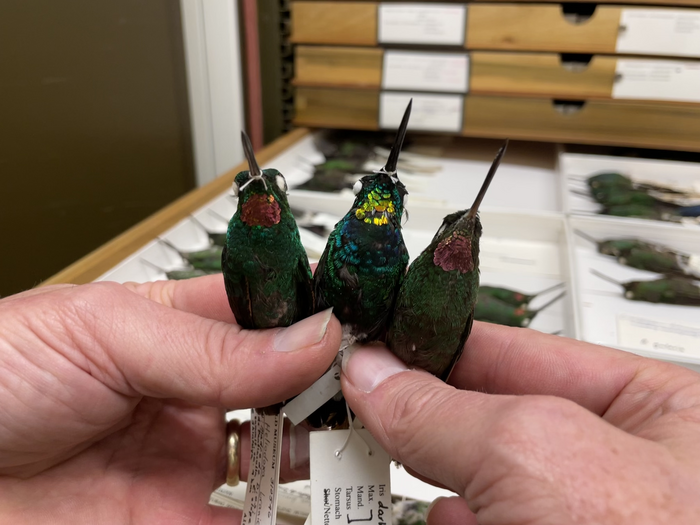The Pink-throated Brilliant hummingbird, Heliodoxa gularis, has, unsurprisingly, a brilliant pink throat. So does its cousin, the Rufous-webbed Brilliant hummingbird, Heliodoxa branickii. When scientists found a Heliodoxa hummingbird with a glittering gold throat, they thought they might have found a new species. DNA revealed a different story: the gold-throated bird was a never-before-documented hybrid of the two pink-throated species.

Credit: Kate Golembiewski, Field Museum
The Pink-throated Brilliant hummingbird, Heliodoxa gularis, has, unsurprisingly, a brilliant pink throat. So does its cousin, the Rufous-webbed Brilliant hummingbird, Heliodoxa branickii. When scientists found a Heliodoxa hummingbird with a glittering gold throat, they thought they might have found a new species. DNA revealed a different story: the gold-throated bird was a never-before-documented hybrid of the two pink-throated species.
John Bates, the senior author of a new study in the journal Royal Society Open Science reporting on the hybrid, first encountered the unusual bird while doing fieldwork in Peru’s Cordillera Azul National Park, which protects an outer ridge on the eastern slopes of Andes mountains. Since the area is isolated, it would make sense for a genetically distinct population to emerge there. “I looked at the bird and said to myself, ‘This thing doesn’t look like anything else.’ My first thought was, it was a new species,” says Bates, a curator of birds at Chicago’s Field Museum.
When Bates and colleagues gathered more data about the specimen in the Field Museum’s Pritzker DNA Lab, however, the results surprised everyone. “We thought it would be genetically distinct, but it matched Heliodoxa branickii in some markers, one of the pink-throated hummingbirds from that general area of Peru,” says Bates. If it was H. branickii, it didn’t make sense for the bird to have gold throat feathers; in the hummingbird family, it’s rare for members of the same species to have dramatically different throat colors.
The initial run of DNA sequencing looked at mitochondrial DNA, a type of genetic material that only gets passed down through the mother. That mitochondrial DNA gave a clear result matching H. branickii; the researchers then analyzed the bird’s nuclear DNA, which includes contributions from both parents. This time, the DNA showed similarities to both H. branickii and its cousin, H. gularis. It wasn’t half branickii and half gularis, though– one of its ancestors must have been half-and-half, and then later generations mated with more branickii birds.
The question remained how two pink-throated bird species could produce a non-pink-throated hybrid. The study’s first author, Field Museum senior research scientist Chad Eliason, says the answer lies in the complex ways in which iridescent feather colors are determined.
“It’s a little like cooking: if you mix salt and water, you kind of know what you’re gonna get, but mixing two complex recipes together might give more unpredictable results,” says Eliason. “This hybrid is a mix of two complex recipes for a feather from its two parent species.”
Feathers get their base color from pigment, like melanin (black) and carotidnoids (red and yellow). But the structure of feathers’ cells and the way light bounces off them can also produce something called structural color. Color-shifting iridescence is a result of structural color.
The researchers used an electron microscope to examine the throat feather structure on a subcellular level, and an analytical technique called spectroscopy to measure how light bounces off the feathers to produce different colors. They found subtle differences in the origin of the parents’ colors, which explain why their hybrid offspring produced a totally different color.
“There’s more than one way to make magenta with iridescence,” says Eliason. “The parent species each have their own way of making magenta, which is, I think, why you can have this nonlinear or surprising outcome when you mix together those two recipes for producing a feather color.”
While this study helps explain the strange coloration of one unusual bird, the researchers say that it opens the door to more questions about hybridization.
Separate species are generally defined as lineages that are genetically distinct and don’t interbreed with each other; hybrids break that rule. Sometimes hybrids are weird one-offs or are sterile, like mules; in other cases, hybrids can form new species. It’s not clear how common hummingbird hybrids like the one in this study are, but the researchers speculate that hybrids like this one might contribute to the diversity of structural colors found across the hummingbird family tree.
“Based on the speed of color evolution seen in hummingbirds, we calculated it would take 6-10 million years for this drastic pink-gold color shift to evolve in a single species,” says Eliason.
Co-author Mark Hauber at the University of Illinois Urbana-Champaign adds that “this study gives us clues about the nanostructural basis of evolutionary shifts in color.”
This study was contributed to by Bates’s and Eliason’s Field Museum colleagues Jacob Cooper (now at the University of Kansas), Shannon Hackett, Erica Zahnle, Dylan Maddox, and Taylor Hains, as well as Tatiana Paqueño Saco (Peruvian Ministry of Natural Resources) and Mark Hauber (University of Illinois, Urbana-Champaign).
###
Journal
Royal Society Open Science
Subject of Research
Animals
Article Title
Interspecific hybridization explains rapid gorget color divergence in Heliodoxa hummingbirds (Aves: Trochilidae)
Article Publication Date
28-Feb-2023




